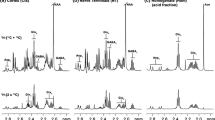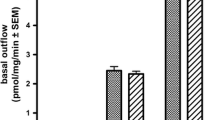Abstract
Rapid changes in transglutaminase (TG) activity,45Ca2+ — influx and [3H]leucine incorporation in superior cervical ganglia (SCG), and nodose ganglia (NG) excised from adult rats were examined following addition of membrane-depolarizing agents veratridine (Ver) or high extracellular [K+]o during aerobic incubation in vitro at 37°C. Addition of KCl (50mM) stimulated TG activity to a maximal extent (four to sixfold) in SCG and NG after 30 min. Ver (0.2 mM) also increased TG activity in both ganglia after 30 min. Kinetic studies showed that the stimulation of TG activity in both ganglia caused by each depolarization condition was associated with a decrease inK m and an increase inV max value. The depolarizing agents Ver and high [K+]o also caused significant increases in45Ca2+ influx into both ganglia. The Ver-induced increases in TG activity and45Ca2+ accumulation were antagonized by tetrodotoxin (TTX, 1 μM), a sodium channel blocker. The K+-induced increase in TG activity was not blocked by tetraethylammonium (TEA, 20 mM), a potassium channel antagonist, although TEA did block the K+-induced increase in45Ca2+ accumulation. The membrane-perturbing, sialic acid-containing compounds, GM1-ganglioside (GM1, 5 nM) and α-sialyl cholesterol (α-SC, 20 μM), were moderate inhibitors of the K+-induced effects on TG activity and45Ca2+ accumulation. The sialyl compounds had little effect on Ver-induced accumulation of45Ca2+ but enhanced the Ver-evoked stimulation in TG activity. These results suggests that the veratridine-and K+-induced increases in TG activity occur via modulation of Ca2+ and Na+ channel gating mechanisms that are pharmacologically distinct for each depolarizing agent. The veratridine- and K+-induced decrease in [3H]leucine incorporation could be a result of stimulation of TG activity as a consequence of degenerative alterations.
Similar content being viewed by others
Abbreviations
- SCG:
-
superior cervical (sympathetic) ganglia
- NG:
-
nodose ganglia
- TG:
-
transglutaminase
- HEPES:
-
N-2-hydroxyethylpiperazine-N′-ethanesulfonic acid
- GM1:
-
ganglioside
- GM1:
-
ganglioside, GM1
- α-SC:
-
α-sialyl cholesterol
- TTX:
-
tetrodotoxin
- TEA:
-
tetraethylammonium
- TCA:
-
trichloroacetic acid
References
Ando M., Miwa M., and Nagata Y. (1984) Effects of various kinds of stimulation on ornithine decarboxylase activity in superior cervical sympathetic and nodose ganglia of rats.Cell. Mol. Neurobiol 4, 79–90.
Ando M., Nakashima Y., and Nagata Y. (1990) Effects of GM1-ganglioside and alpha-sialyl cholesterol in amino acid uptake, protein synthesis, and Na+, K+-ATPase activity in superior cervical and nodose ganglia excised from adult rats.Mol. Chem. Neuropathol. 13, 33–46.
Ando M., Nakashima Y., and Nagata Y. (1991a) Stimulation of transglutaminase activity by GM1-ganglioside and alpha-sialyl cholesterol in superior cervical and nodose ganglia excised from adult rat.J. Neurochem. 57, 1848–1854.
Ando M., Nakashima Y., and Nagata Y. (1991b) Stimulation by acetylcholine and inhibition by norepinephrine of transglutaminase activity in superior cervical ganglia excised from adult rats.Neurosci. Res. 11, 356–365.
Blaustein M. P. (1971) Preganglionic stimulation increases calcium uptake by sympathetic ganglia.Science 172, 391–393.
Blaustein M. P. (1976) Barbiturates block calcium uptake by stimulated and potassium-depolarized rat sympathetic ganglia.J. Pharmacol. Exp. Ther. 196, 80–86.
Bradford M. M. (1976) A rapid and sensitive method for the quantitation of microgram quantities of protein utilizing the principle of protein-dye binding.Anal. Biochem. 72, 248–252.
Folk J. E. (1980) Transglutaminase.Ann. Rev. Biochem. 49, 517–531.
Friedrich P., Fesus L., Tarcsa E., and Czeh G. (1991) Protein cross-linking by transglutaminase induced in long-term potentiation in the CA1 region of hippocampal slices.Neuroscience 43, 331–343.
Gilad G. M., Varon L. E., and Gilad V. H. (1985) Calcium-dependent transglutaminase of rat sympathetic neuron after axonal injury.J. Neurochem. 44, 1385–1390.
Katz B. and Miledi R. (1967) A study of synaptic transmission in the absence of impulses.J. Physiol. (Lond.) 192, 407–436.
Kelly J. and Rogawski M. A. (1985) Acetylcholine, inNeurotransmitter Actions in the Vertebrate Nervious System (Rogawski M. A. and Baker J. L., eds.), pp. 143–197, Plenum, New York.
Klingman J. D. (1982) Autonomic ganglia and their biochemistry, inHandbook of Neurochemistry, vol. 3 (Lajitha A., ed.), pp. 417–464, Plenum, New York.
Kusano K., Livengood D. R., and Werman R., (1967) Correlation of transmitter release with membrane properties of the synaptic fiber of the squid giant synapses.J. Gen. Physiol. 50, 2579–2601.
Llinas R. and Nicholson C. (1975) Calcium role in depolarization-released coupling. An aequorin study in squid giant synapse.Proc. Natl. Acad. Sci. USA 72, 187–190.
Lorand L. and Conrad S. M. (1984) Transglutaminase.Mol. Cell. Biochem. 59, 9–35.
Lorand L., Campbell-Wilkes L. K., and Cooperstein L. (1972) A filter paper assay for transamidating enzymes using radioactive amine substrates.Anal. Biochem. 50, 623–631.
Nagata Y., Mikoshiba K., and Tsukada Y. (1973) Effect of potassium ions on glucose and phospholipid metabolism in rats’ cervical sympathetic ganglia with and without axotomy.Brain Res. 56, 259–269.
Takagaki G. and Tsukada Y. (1957) Effect of some inorganic ions on brain slices metabolizing glucose or pyruvate.J. Neurochem. 2, 21–29.
Tetzlaff W., Gilad V. H., Leonard C., Bisby M. A., and Gilad G. M. (1988) Retrograde changes in transglutaminase activity after peripheral nerve injuries.Brain Res. 445, 142–146.
Volle R. L., Quenzer L. F., Patterson B. A., Alkadhi K. A. and Henderson E. G. (1981) Cyclic guanosine 3′, 5′-monophosphate accumulation and45Ca-uptake by rat superior cervical ganglia during preganglionic stimulation.J. Pharmacol. Exp. Ther. 219, 338–343.
Wieloch T. (1985) Neurochemical correlate to selective neuronal vulnerability.Prog. Brain Res. 63, 69–85.
Wieraszuko A. and Seifert W. (1985) The role of monosialoganglioside GM1 in the synaptic plasticity: in vitro study on rat hippocampal slices.Brain Res. 345, 159–164.
Author information
Authors and Affiliations
Rights and permissions
About this article
Cite this article
Ando, M., Nagata, Y. Effects of depolarizing agents on transglutaminase activity, Ca2+ influx, and protein synthesis in superior cervical and nodose ganglia excised from rats. Molecular and Chemical Neuropathology 19, 121–135 (1993). https://doi.org/10.1007/BF03160173
Received:
Accepted:
Issue Date:
DOI: https://doi.org/10.1007/BF03160173




